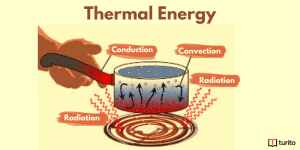Overview
Meaning: Transmission of heat energy through liquid or gaseous medium by warmer material moving into a cooler location, is called convection. In this article, students will learn about what is convection and shall look at some common examples of this phenomenon.
Before moving forward, students need to comprehend the definition to know what convection is. It is a phenomenon where heat energy is transferred via liquids or gases, resulting in the rise of hotter materials and the fall of cooler materials. It is because hotter materials have much less concentration than cooler ones.
According to meteorology, It is the transmission of atmospheric or heat elements through the motion of volumes of air, especially in an upward motion, in meteorology. Similarly, according to geology, It is a steady transmission of material beneath the earth’s surface.
What is Convection?
Definition: Convection currents are movements of fluid caused by the difference in density or temperature within a subject matter. Convection currents are only observable in liquids or gases because the molecules in solids are tightly packed in their places.
A temperature differential causes energy to be transferred from a higher (hotter) energy area to a lower (colder) energy area. It is a type of heat transmission where matter is transferred from one point to another on the formation of currents. The result can also be defined as the mass transfer process.
Convection current plays a crucial role in natural ventilation and wind patterns. Wind movement worldwide is influenced by numerous locations where hot air rises upwards, and cold air sinks downwards, resulting in a change of weather.
For instance, during the daytime, air over the earth’s surface is often heated by the sun, whilst air over water remains chilly. Thereby initiating the rise of warmer air (because of low density) from the earth’s surface towards the skies. As it rises, it cools down and becomes denser again, resulting in the fall down (sink) of air again.
Convection meaning is a physical phenomenon that incorporates the exchange of heat energy between two matters at different temperatures, at minimum, one of which is fluid (gas or liquid) and occurs on the fluid medium near the dividing surfaces. Typically, fluid movement can be assumed static. So It can be measured by considering the outcomes of a ratio between the incoming and outgoing energy fluxes caused by the modern effects of heat transfer and mass transportation.
Common Everyday Examples of Convection
In everyday life, there are countless examples of convection meaning, along with several everyday home occurrences.
- When a person boils the water, the heat energy is transferred from the stove to the kettle, boiling the water at the bottom. This hot water rises, and cooler water flows downward to replace it, resulting in a rotational movement of the fluid.
- A radiator emits heated air at the top and pulls colder air at the bottom.
- The steam a cup of hot tea produces shows that heat is transported into the air.
- Ice melts from heat moving from the atmosphere to the ice. As a consequence, the ice transforms from solid to liquid.
- Frozen food defrosts faster under running water than if kept in water. It is because the movement of running water distributes heat faster into the frozen food than what is kept in still water.
- A fan, suction device or pump is a common example of forced convection. Some of the everyday devices which use these elements are examples: air conditioners, convection ovens, car radiators, and central heating; these devices use a fluid to rotate the heat energy in a circular motion.
Types of Convection
It is of two types, natural or free and forced convection. Natural refers to occurring naturally. At the same time, when a gas fluid is transferred using a pump fan. The cells generated in currents are known as Bénard cells.
| Interesting Facts
A supercell is a much more extreme form of a convective thunderstorm. This sort of storm usually lasts for more than one hour and has a high possibility of producing severe tornadoes. |
Natural Convection
It is caused by a change in density in fluids (gas or liquid) caused by temperature differences (for example, “hot air rises and cold air sinks”). Convective heat transfer is caused by global atmospheric temperature and local meteorological phenomena (including wind).
Forced Convection
Under forced convection, fluids (gases or liquids) are transferred via a fan or a pump. Forced convection is one of the most common types of heat transfer used by engineers since it allows rapid transportation of massive quantities of heat energy from one location to another. It is utilised in electronic cooling, cooling and heating systems, and various other technologies. Forced convection is employed in the construction of heat exchangers, which use one fluid flow to heat and another to cool.
Newton’s law of cooling is connected to forced convection, which is expressed as:
P = dQ/dT = hA (T – T0)
P = dQ/dT defines the rate of heat transmission
A = surface area
h = heat-transfer convection coefficient
T = temperature of the immersed object
T0 = temperature of the fluid which is under convection
The value of h, heat-transfer coefficient is determined by:
- Viscosity
- Density
- Specific Heat Capacity
- Thermal Conductivity
How is Convection Formed?
A substantial difference in temperature causes the particles of matter to move from one (hotter) location to another (colder) location, resulting in the formation of the convection current. A temperature difference causes zones of higher and lower densities of plasma (liquids) and gas molecules or atoms to flow to occupy regions with low pressure.
In a nutshell, warm fluids rise upwards while cold fluids fall downwards (sink). Convection currents persist only till a homogeneous temperature is obtained until a source of energy (e.g., sunshine, heat) is available. Scientists examine the various forces operating on a fluid to comprehend and address convection meaning. Among these forces are:
- Gravity
- Vibrations
- Concentration differences
- Surface tension
- Electromagnetic fields
- Bond formation between molecules
Convection currents can be modelled using scalar or linear transport equations called convection-diffusion equations.
| Interesting Fact:
The stack effect, also known as the chimney effect, is an inward and outward movement of air from flues, buildings, or other objects due to buoyancy. In this situation, buoyancy refers to the difference in air density between the internal and external air. The buoyancy rate increases as the structure’s height increases and the temperature differential between the indoor and outdoor air increases. |
Conclusion
It is a method of moving heat known as a heat transfer process. Heat is transferred when a fluid, including water or air, is in circulation. Temperature variations throughout the fluid induce convection. When the fluids ( gases or liquids) are heated, the section nearest to the heat source gets less dense because the molecules’ kinetic energy increases.
The less-dense component of the fluid rises, whereas the denser section of the fluid sinks. The process is repeated since less dense fluids drop their temperature as they travel away from heat or warm sources, causing them to lose their temperature, sinking or falling downwards. In comparison, denser or colder fluids heat up as they approach the heat source, causing them to lose their density and rise upwards. It results in convection currents.
Frequently Asked Questions
1. Suggest a few examples to define convection in meteorology.
Ans. It is the consequence of various weather phenomena. According to meteorology, It is simply an upward movement of heated air in the atmosphere. It seems quite simple, but it might lead to severe weather in some conditions.
Convective clouds occur when there is a lot of water in the atmosphere, and convection currents move water droplets into the atmosphere. When enough droplets accumulate in the clouds, it will result in the formation of rain along with connective thunderstorms.
Squall lines are a form of convective thunderstorms. This convective occurrence creates a line of thunderstorms, along with strong winds and pouring rain.
2. Suggest a few examples to define convection in the movement of air.
Ans. There are several different examples of convection linked with the movement of air. These examples are less frequently seen than the real-world examples of convection that occur at home or due to certain weather phenomena.
Hot air balloon – The burner in a hot air balloon raises the temperature of the air, allowing it to rise. The hot air gets trapped within the balloon, allowing the balloon to rise. When the passengers wish to drop it, they turn off the burner to expel the hot air from the balloon. Thereby allowing the cool air to replace the warm air, forcing the balloon to come to the surface.
3. How does convection transport heat?
Ans. Temperature expansion occurs when a fluid (gas or liquid) is heated from the bottom. The lower hotter fluid (liquid or gas) becomes less dense. The less-dense, hotter section of the fluid rises in the upward motion due to buoyancy.
And it is replaced by cooler, denser fluid. This circular movement of fluid continues till the other sections are also heated up and rise to be replaced by the cooler upper layer. In this way, heat is transported through convection.

Relevant Articles
Understanding Thermal Energy: What It Is and How It Works
Thermal energy is essential to our daily lives, from warming …
Understanding Thermal Energy: What It Is and How It Works Read More »
Read More >>Avogadro’s Number: Meaning, Importance, and More
Introduction The concept of measuring the microscopic particles that make …
Avogadro’s Number: Meaning, Importance, and More Read More »
Read More >>Kinetic Friction – Definition, Laws, Types
Kinetic Friction Kinetic force is a force acting between two …
Kinetic Friction – Definition, Laws, Types Read More »
Read More >>




















Comments: